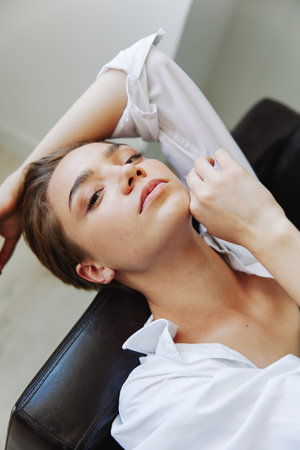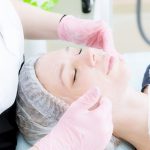1. Introduction to Eyelid Tightening Procedures
As we age, the skin around our eyes loses elasticity, leading to sagging eyelids and fine lines. Many people seek solutions to restore a youthful appearance without undergoing invasive surgery. This has led to the rise of non-surgical eyelid tightening treatments, with radiofrequency (RF) and ultrasound-based procedures becoming two of the most popular options.
Why Choose Non-Surgical Eyelid Tightening?
Traditional eyelid surgery, or blepharoplasty, is an effective way to remove excess skin and tighten the area around the eyes. However, surgery involves downtime, potential risks, and higher costs. Non-surgical alternatives like RF and ultrasound offer a way to achieve firmer skin with minimal discomfort and recovery time.
How Do These Treatments Work?
- Radiofrequency (RF): Uses energy waves to heat the deeper layers of the skin, stimulating collagen production and tightening loose skin.
- Ultrasound: Delivers focused ultrasound energy to deeper tissue layers, promoting collagen growth for firmer, smoother eyelids.
The Growing Popularity of RF and Ultrasound Treatments
The demand for non-invasive cosmetic procedures has surged in recent years. More people are looking for ways to enhance their appearance without surgery, making RF and ultrasound treatments increasingly popular choices. These methods provide noticeable results while allowing patients to resume their daily activities almost immediately.
2. How Radiofrequency Eyelid Tightening Works
Radiofrequency (RF) eyelid tightening is a non-invasive cosmetic procedure that uses energy waves to stimulate collagen production. This treatment is popular for individuals looking to reduce sagging skin around the eyes without undergoing surgery. But how does it work? Let’s break it down.
Understanding RF Technology
RF technology works by delivering controlled heat energy deep into the skin layers. Unlike lasers, which target the surface of the skin, RF penetrates deeper to affect the underlying tissue. The heat generated from RF energy triggers the body’s natural healing process, stimulating collagen and elastin production.
How RF Stimulates Collagen Production
Collagen is a crucial protein that keeps skin firm and youthful. As we age, collagen production decreases, leading to fine lines, wrinkles, and loose skin. RF treatment helps counteract this process by:
- Heating the deeper layers of the skin to encourage new collagen growth.
- Tightening existing collagen fibers for an immediate lifting effect.
- Promoting long-term skin remodeling for gradual improvements over time.
The Impact of RF on Eyelid Skin Tightening
When applied to the delicate eyelid area, RF technology offers noticeable results without damaging the skin’s surface. Patients typically experience:
| Benefit | Description |
|---|---|
| Non-Invasive | No incisions or downtime required. |
| Gradual Improvement | Results become more visible over weeks as collagen rebuilds. |
| Painless Procedure | Mild warmth during treatment but no significant discomfort. |
| Smoother Skin Texture | Tightens loose skin and reduces fine lines. |
Who Can Benefit from RF Eyelid Tightening?
This treatment is ideal for individuals with mild to moderate eyelid laxity who want a firmer appearance without surgery. It’s also suitable for those looking for preventive anti-aging solutions. However, results vary based on skin type, age, and individual response to treatment.

3. How Ultrasound Eyelid Tightening Works
Ultrasound-based treatments, like Ultherapy, have gained popularity for their ability to lift and tighten the skin around the eyes without surgery. Unlike radiofrequency (RF) treatments, which primarily heat the outer layers of the skin, ultrasound technology penetrates deeper to stimulate collagen production at a more foundational level.
How Ultrasound Technology Works
Ultrasound eyelid tightening uses focused ultrasound energy to target specific depths of the skin and underlying tissue. The energy creates micro-injuries in these deeper layers, triggering the body’s natural healing response and encouraging collagen and elastin production. This results in firmer, more youthful-looking skin over time.
Ultrasound vs. Radiofrequency: Key Differences
| Feature | Ultrasound (e.g., Ultherapy) | Radiofrequency (RF) |
|---|---|---|
| Penetration Depth | Targets deeper layers, including the SMAS (Superficial Musculoaponeurotic System) | Affects more superficial layers of the skin |
| Main Mechanism | Uses sound waves to stimulate collagen at precise depths | Uses electromagnetic waves to generate heat and tighten skin |
| Treatment Results | Takes several months for full effects as collagen rebuilds | Smoother skin with faster initial results but may require more sessions |
| Pain Level | Mild to moderate discomfort during treatment | |
| Suitability | Best for mild to moderate skin laxity; effective for deep lifting | Ideal for fine lines, wrinkles, and surface-level tightening |
| Treatment Frequency | A single session can last up to a year or more | A series of treatments is typically needed for best results |
The Benefits of Ultrasound Eyelid Tightening
- No Downtime: Patients can resume daily activities immediately after treatment.
- Naturally Stimulates Collagen: Encourages long-term improvements by boosting collagen production.
- Treats Deeper Layers: Can reach structures that are typically only accessible through surgical procedures.
- Lifting Effect: Particularly effective for sagging eyelids and loose skin.
Pacing Expectations: When Will You See Results?
The effects of ultrasound eyelid tightening develop gradually over several months. While some patients notice an immediate slight improvement due to initial tissue contraction, the real benefits appear as new collagen forms, usually within 2–6 months post-treatment.
This makes ultrasound-based eyelid tightening a great option for those looking for long-lasting improvement without undergoing surgery. However, understanding its differences from RF treatments can help determine which method aligns best with your aesthetic goals.
4. Pros and Cons of Radiofrequency vs. Ultrasound
When it comes to non-surgical eyelid tightening, both radiofrequency (RF) and ultrasound treatments offer unique benefits. However, they also come with certain drawbacks. Below is a comparative analysis of their effectiveness, treatment comfort, recovery time, and suitability for different skin types.
Effectiveness
Both RF and ultrasound technology can tighten the eyelid area by stimulating collagen production, but they work differently. RF heats the skin’s surface layers, leading to gradual skin tightening over multiple sessions. Ultrasound penetrates deeper into the tissue and may provide more dramatic results after just one session.
| Treatment | Effectiveness |
|---|---|
| Radiofrequency (RF) | Mild to moderate tightening; requires multiple sessions for optimal results. |
| Ultrasound | More intense tightening; often noticeable after a single treatment. |
Treatment Comfort
The comfort level during treatment varies between these two technologies. RF is generally well tolerated, producing a warm sensation on the skin. Ultrasound treatments, however, can be slightly more uncomfortable due to deeper penetration, sometimes causing temporary discomfort.
| Treatment | Treatment Sensation |
|---|---|
| Radiofrequency (RF) | A warm, tolerable sensation with minimal discomfort. |
| Ultrasound | A deeper heating sensation that may cause mild discomfort during treatment. |
Recovery Time
If you’re looking for minimal downtime, both treatments are good options. RF typically has no downtime at all, while ultrasound may cause slight redness or swelling that resolves within a few days.
| Treatment | Recovery Time |
|---|---|
| Radiofrequency (RF) | No downtime; you can return to daily activities immediately. |
| Ultrasound | Mild redness or swelling for 1-2 days in some cases. |
Suitability for Different Skin Types
Your skin type and concerns play a role in determining which treatment is best for you. RF is generally safe for all skin tones and types since it targets the outer layers of the skin without affecting pigmentation. Ultrasound penetrates deeper into the tissue and works well for those seeking more dramatic lifting effects but might not be ideal for extremely thin or sensitive skin.
| Treatment | Best Suited For |
|---|---|
| Radiofrequency (RF) | Sensitive skin and all skin tones; great for mild laxity. |
| Ultrasound | Mature skin with moderate laxity; may not be ideal for very thin skin. |
The choice between RF and ultrasound eyelid tightening depends on your individual needs, tolerance level, and desired outcome. Understanding these differences can help you make an informed decision about which treatment is best suited for your goals.
5. Who Should Choose RF or Ultrasound?
Choosing between radiofrequency (RF) and ultrasound eyelid tightening depends on several factors, including age, skin laxity, sensitivity, budget, and desired results. Both treatments offer non-invasive skin tightening, but they work differently and may be better suited for different individuals.
Factors to Consider
Age and Skin Laxity
RF is typically recommended for individuals with mild to moderate skin laxity, as it focuses on stimulating collagen production in the superficial layers of the skin. Ultrasound, on the other hand, penetrates deeper and may be better for those with more significant sagging or older skin.
Skin Sensitivity
If you have sensitive skin, RF may be a gentler option since it delivers controlled heat without intense energy pulses. Ultrasound treatments can sometimes cause mild discomfort or temporary swelling due to their deeper penetration.
Budget Considerations
The cost of these treatments can vary based on location and provider. In general, RF treatments tend to be more affordable than ultrasound because they require fewer resources and are quicker to perform.
Desired Results
If youre looking for subtle improvements with minimal downtime, RF is a great option. However, if you want a more dramatic lifting effect that lasts longer, ultrasound may provide better outcomes.
Comparison Table: RF vs. Ultrasound Eyelid Tightening
| Factor | Radiofrequency (RF) | Ultrasound |
|---|---|---|
| Best for Skin Laxity Level | Mild to moderate | Moderate to severe |
| Sensitivity | Gentler on sensitive skin | Mild discomfort possible |
| Treatment Cost | $ – More affordable | $$$ – Higher cost |
| Treatment Depth | Affects superficial layers | Affects deeper layers |
| Results Longevity | Mild improvement over time | Dramatic lifting effect lasting longer |
| Pain Level | Mild warmth sensation | Mild to moderate discomfort possible |
| Treatment Sessions Needed | Multiple sessions required for best results | A single session may be enough for some patients |
| Dramatic Results? | No – More gradual improvement over time | Yes – Noticeable lift after treatment |
Which One Is Right for You?
If youre in your 30s or 40s with early signs of sagging and want a gentle, gradual improvement, RF might be the best choice. However, if youre in your 50s or beyond and need a more significant lift with long-lasting effects, ultrasound may deliver better results.
The best way to determine which treatment suits you is by consulting an experienced provider who can assess your skin condition and recommend the most effective option based on your needs.
6. Final Thoughts and Expert Recommendations
When it comes to eyelid tightening, both radiofrequency (RF) and ultrasound treatments offer unique benefits. Choosing the right option depends on your specific skin concerns, pain tolerance, budget, and desired results.
Key Takeaways
| Factor | Radiofrequency (RF) | Ultrasound |
|---|---|---|
| How It Works | Uses controlled heat to stimulate collagen production | Uses focused ultrasound energy to tighten deep layers of skin |
| Effectiveness | Great for mild to moderate skin laxity | Better for deeper tissue tightening and more significant sagging |
| Pain Level | Mild discomfort, usually well tolerated | Can be more painful due to deeper penetration |
| Treatment Sessions | Multiple sessions often needed for best results | Fewer sessions required, sometimes just one treatment |
| Downtime | Minimal to none, mild redness possible | Slight swelling or tenderness may last a few days |
| Cost | Generally lower cost per session | Tends to be more expensive per session |
| Longevity of Results | Results last up to 1 year with maintenance treatments | Results can last 1-2 years or longer in some cases |
| Best For… | Younger individuals or those with mild sagging looking for gradual improvements | Individuals with moderate to severe sagging seeking a stronger lift effect |
Expert Recommendations for Optimal Results
1. Consult a Qualified Provider
The success of any eyelid tightening treatment depends largely on the expertise of the provider. Always choose a board-certified dermatologist or medical professional with experience in non-surgical skin tightening techniques.
2. Consider Your Skin Type and Goals
If you have mild sagging and prefer a gradual improvement with minimal discomfort, RF might be your best bet. If youre looking for a stronger lift and don’t mind slight downtime or discomfort, ultrasound could be the better choice.
3. Combine Treatments for Enhanced Results
Some patients see optimal results by combining RF and ultrasound treatments. RF can improve surface texture while ultrasound works on deeper layers for overall firming.
4. Follow Aftercare Instructions Carefully
No matter which treatment you choose, proper aftercare is essential. Keep the treated area moisturized, avoid excessive sun exposure, and follow any post-procedure guidelines given by your provider.
5. Maintain Realistic Expectations
Eyelid tightening treatments offer noticeable but natural-looking improvements. While they can enhance firmness and reduce sagging, they do not replace surgical options like blepharoplasty for severe eyelid laxity.
Ultimately, both RF and ultrasound eyelid tightening are excellent non-invasive options that can help you achieve a more youthful and refreshed appearance. The key is to choose the right treatment based on your individual needs and consult an experienced professional for the safest and most effective results.


